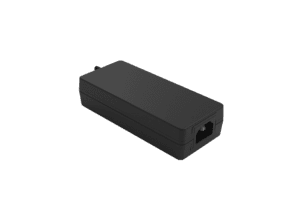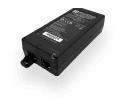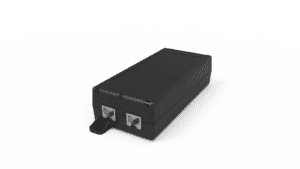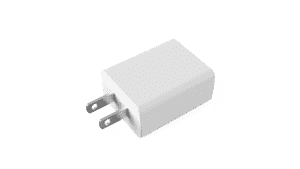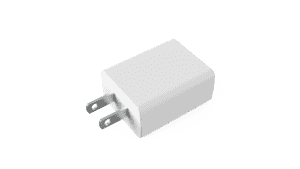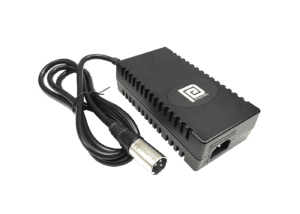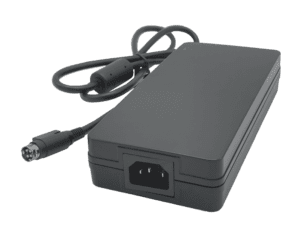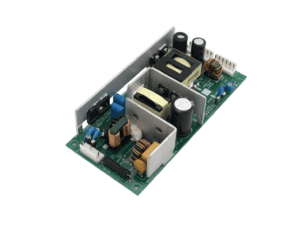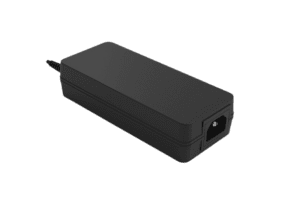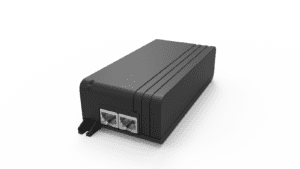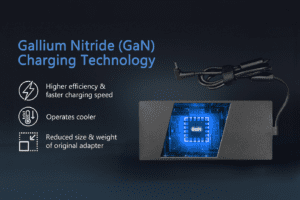BLOG
AC Adapter Guide: Everything You Need to Know
Table of contents

AC adapters are vital, yet, often overlooked devices that power our precious electronics. It’s the only way to charge your smartphone, your laptops, and anything that requires electricity to work. But what exactly is an adapter? This comprehensive guide will explore everything you need to know about adapters, from their technical workings to their environmental impact and future trends.
What Is an Adapter?
An adapter, in the simplest terms, is a device that allows one type of system or component to connect and function with another. The term “adapter” encompasses various devices across multiple domains—power, video, audio, networking, and more. However, the most common type of adapter is the power adapter, which converts electrical energy from a power source to a form that is compatible with electronic devices.
For instance, when you charge your laptop or smartphone, you’re using a power adapter to convert the high-voltage alternating current (AC) from your wall outlet into a lower-voltage direct current (DC) that your device can safely use. Without adapters, most electronic devices would be unable to connect to the grid, making them essential in our everyday lives.
How Adapters Work: A Technical Breakdown
Understanding how adapters work involves looking at the individual steps it takes to convert and regulate power into viable electricity. Let’s break down the components in more detail:
- Transformer: The transformer, the heart of the adapter, changes voltage levels by stepping up or down the incoming voltage. It operates on electromagnetic induction, where an alternating current in the primary winding creates a magnetic field that induces a current in the secondary winding, with the turn ratio determining the output voltage. This process adjusts high AC voltages from wall outlets (110-120V AC or 220-240V AC) to the lower DC voltages (such as 5V or 12V DC) needed by most electronic devices.
- Rectifier: After the voltage is reduced, it needs to be converted from alternating current (AC) to direct current (DC), as most electronics require DC. This conversion is handled by a rectifier, which uses diodes to transform the bidirectional AC flow into a unidirectional DC flow. Rectifiers can range from a single diode to a more complex bridge rectifier with four diodes, with modern adapters often using full-wave rectifiers to produce a smoother DC output by utilizing both halves of the AC cycle.
- Filter: After rectification, the DC current may still have ripples or fluctuations, which are smoothed out by a filter. Filters, typically consisting of capacitors, store and release electrical energy to stabilize the DC output. More advanced adapters may also use inductors to further filter out high-frequency noise, ensuring a cleaner power supply for sensitive electronics.
- Voltage Regulator: Finally, a voltage regulator maintains a consistent output voltage despite variations in input voltage or power demands, crucial for preventing damage from overvoltage or undervoltage. Voltage regulators come in various forms: linear regulators provide steady output by dissipating excess power as heat, while more advanced switching regulators use high-frequency switching for better efficiency and smaller size. Switching regulators are more commonly used in modern adapters for their superior efficiency.
The combination of these components ensures that your devices receive the correct voltage and current for optimal performance.
History of the Adapter Evolution
The development of adapters has a rich and varied history that mirrors the evolution of electrical technology itself. The origins of adapters trace back to the late 19th and early 20th centuries, a time when the electrical industry was in its infancy. Early adapters, primarily rudimentary transformers, were designed to convert voltages to meet different application needs. These simple devices laid the groundwork for adapting electrical power, making it more versatile for various uses and setting the stage for future innovations.
As electrical technology advanced, so did the complexity and functionality of adapters. The mid-20th century marked a significant leap with the advent of semiconductor technology. This era introduced essential components such as rectifiers and voltage regulators. Rectifiers transformed alternating current (AC) into direct current (DC), a crucial development for powering a wide range of electronic devices. Voltage regulators emerged as a vital innovation, providing consistent and stable output voltages. These advancements represented a major shift towards more precise and reliable power conversion, moving beyond the basic voltage adjustment of earlier devices.
The progression didn’t stop there. The late 20th and early 21st centuries brought about the miniaturization of electronic components, revolutionizing the design of adapters. As semiconductor technology became more advanced, adapters evolved from bulky, cumbersome units into sleek, compact devices. The integration of integrated circuits (ICs) played a crucial role in this transformation, allowing for more sophisticated power management and regulation within a smaller footprint. This miniaturization not only improved performance but also enhanced the safety and efficiency of adapters.
In recent decades, the focus has shifted towards incorporating advanced power management features into modern adapters. These features include mechanisms for overvoltage protection, thermal regulation, and enhanced energy efficiency. Overvoltage protection safeguards electronic devices from potential damage caused by voltage spikes, while thermal regulation prevents overheating and ensures stable operation. The emphasis on energy efficiency reflects a broader commitment to environmental sustainability, with modern adapters designed to minimize energy waste and reduce their carbon footprint.
Today’s adapters are the culmination of over a century of technological evolution, embodying advancements in electrical engineering and semiconductor technology. From their humble beginnings as simple voltage converters to their current state of sophisticated power management tools, adapters have undergone significant transformations. These changes not only highlight the broader advancements in electrical and electronic technologies but also underscore the ongoing pursuit of greater performance, safety, and efficiency in the world of power conversion.
Types of Power Adapters
AC Adapters
AC adapters are among the most common types of power adapters, converting alternating current (AC) from a wall outlet into direct current (DC) used by many electronic devices. They are crucial because most electronic devices require DC power to operate, even though the electrical supply from standard outlets is AC. The adapter performs this conversion and regulates the voltage to match the device’s requirements. Used in a wide range of devices, including laptops, smartphones, tablets, and various household electronics, AC adapters are often found as wall adapters or part of external power bricks. They come in various voltages and amperages to suit different devices, such as a laptop adapter providing 19V DC at 3.42A or a phone charger supplying 5V DC at 1A.
USB Adapters
USB adapters have become ubiquitous due to their standardization and versatility. They are designed to work with the USB interface, which is common in many modern devices.
- USB A Adapter: The standard rectangular USB connector found on many computers, chargers, and peripherals. It provides power and data transfer capabilities, with power delivery typically up to 5 watts for USB 2.0 and up to 15 watts for USB 3.0 and later versions.
- USB B Adapter: Usually found on larger peripherals such as printers and scanners, this connector has a square shape with beveled edges. It is less common for modern consumer electronics but still used in some applications.
- USB C Adapter: The latest USB connector standard, known for its reversible design and high power delivery capabilities. USB-C can deliver up to 100 watts of power, handle data transfer rates up to 40 Gbps, and support video output. It is increasingly used for smartphones, laptops, and other high-power devices.
Travel Adapters
Travel adapters are designed to adapt the plug of an electronic device to fit different outlet types around the world. They are especially useful for travelers who need to use their devices in various countries.
- Interchangeable Plug Faces: Some travel adapters come with interchangeable plug faces, allowing users to switch between different plug types depending on the country they are visiting.
- Compatibility: Travel adapters do not convert voltage; they simply allow a device’s plug to fit into different outlets. For devices that require voltage conversion, a voltage converter is needed in addition to the travel adapter.
Ethernet Adapters (Power over Ethernet)
Ethernet adapters that utilize Power over Ethernet (PoE) technology provide both power and data transmission through a single Ethernet cable. This simplifies installation and reduces the need for separate power sources. See the individual “standards” that PoE devices offer in the next section.
- IEEE 802.3af (PoE): Provides up to 15.4 watts of power over Ethernet cables. It is suitable for devices like IP cameras and wireless access points.
- IEEE 802.3at (PoE+): Increases the power delivery to 25.5 watts, accommodating devices with higher power requirements.
- IEEE 802.3bt (PoE++): Further enhances power delivery to 60 watts (Type 3) or 100 watts (Type 4), supporting even more demanding devices.
Modular Adapters
Modular adapters offer flexibility through interchangeable plug components, making them adaptable for various regions and applications.
- Interchangeable Plug Adapters: These adapters come with multiple plug types that can be swapped out based on the region or device requirements. They are particularly useful for international travel or for users who need to connect devices with different plug configurations.
- IEC 60320 Adapters: These adapters conform to the IEC 60320 standard, which specifies power cord connectors used in many devices. Common types include:
- C7/C8: Often used for small appliances like radios and portable electronics.
- C13/C14: Commonly found in computer and server power cords.
- C15/C16: Used in high-temperature applications.
Desktop Adapters
Desktop adapters are power supplies designed to be used with desktop computers and other larger electronic equipment. They provide reliable power to support the device’s operation.
- External Power Bricks: Many desktop adapters come as external bricks that connect to the computer via a power cord. These bricks house the transformer and voltage regulation components.
- Built-In Adapters: Some desktop computers and other electronics have built-in power supplies often called Open-frame/Internal PSUs that are internal to the chassis. These power supplies often handle higher power loads and are designed to fit the design of the electronic device.
Wall Chargers
Wall chargers are compact, plug-in devices designed to provide power directly from a wall outlet. They are commonly used for smartphones, tablets, and other portable electronics.
- Fixed vs. Foldable Plugs: Some wall chargers have fixed plugs, while others feature foldable or retractable plugs for ease of storage and portability.
In summary, the diverse range of power adapters and chargers available today caters to various needs and applications. Whether you’re dealing with AC to DC converters, USB adapters, travel adapters, network adapters, modular adapters, desktop adapters, or wall chargers, each type plays a crucial role in ensuring that electronic devices receive the appropriate power for optimal performance.
Adapters vs. Battery Chargers
Though adapters and battery chargers might seem similar at first glance, they fulfill distinct roles and are designed for different purposes.
An ‘Adapter’ (sometimes referred to as a ‘Power Adapter’) is a power supply unit that converts Alternating Current (AC) from the wall outlet into Direct Current (DC) at a lower, safer voltage suitable for electronic devices. Power adapters are commonly used with devices that do not require a battery for operation, such as PC monitors, routers, and various other electronic equipment. However, many modern battery-operated devices, including laptops, tablets, and smartphones, also rely on power adapters. These adapters provide continuous power to the device while it is in use and, in many cases, while the device’s battery is being charged.
This leads to a common misconception: “If an adapter can keep a device operating while charging the battery, then there’s no difference between an adapter and a charger.” This statement is somewhat misleading. While it is true that many modern devices use power adapters to provide power and charge their internal batteries simultaneously, the roles of adapters and chargers are fundamentally different.
Laptops, tablets, and smartphones have built-in internal battery charger circuits specifically designed to manage the battery charging process when connected to a power adapter. When such a device is plugged in, the power adapter supplies the necessary electricity to keep the device functioning. At the same time, it powers the internal battery charger circuit, which regulates the charging process. This circuit ensures that the battery is charged safely and efficiently, preventing issues such as overcharging, which can lead to overheating and potential hazards.
On the other hand, a ‘Charger’ (or ‘Battery Charger’) is a specialized power supply designed to replenish the energy stored in rechargeable batteries. Chargers convert AC power from the wall into DC power at the appropriate voltage and current levels needed to charge batteries effectively and safely. While many modern portable devices integrate battery charging circuits within the device itself, external battery chargers remain essential for various applications. These include larger and bulkier devices like electric vehicles, external batteries such as power banks, and numerous other devices, including power tools, cameras, and portable gaming devices.
Battery chargers are equipped with additional circuitry that monitors and controls the charging process. This circuitry includes features to safeguard against overcharging and overheating, ensuring that batteries are charged in a controlled and safe manner. For instance, smart chargers for lithium-ion batteries monitor voltage and temperature to prevent potential issues, such as overheating or fires, which could arise from improper charging.
Power Adapter Safety Regulations
Certifications
Power adapters must adhere to stringent safety and performance standards to ensure proper operation and protect users from potential hazards. These standards are verified through various certifications issued by regulatory bodies around the world. Some of the key certifications include:
- UL (Underwriters Laboratories): This certification is vital in North America, ensuring that power adapters meet specific safety and performance benchmarks. UL rigorously tests products to prevent electrical hazards, including fire and shock risks, and verifies that they perform reliably under normal operating conditions.
- CE (Conformité Européenne): The CE mark is essential for products sold within the European Union. It signifies that the power adapter complies with European safety, health, and environmental requirements. Adapters with CE certification have been evaluated for their conformity with European standards and are safe for use in the region.
- FCC (Federal Communications Commission): In the U.S., the FCC certification is required to address concerns related to electromagnetic interference (EMI) and safety. It ensures that electronic devices, including power adapters, do not emit excessive EMI that could interfere with other electronic equipment or pose risks to users.
- EMC (Electromagnetic Compatibility): The EMC certification ensures that power adapters are compatible with other electronic devices and do not cause or suffer from interference. This certification is important for maintaining the seamless operation of multiple devices in close proximity.
Regulatory Standards
In addition to certifications, power adapters must meet specific regulatory standards that focus on both safety and energy efficiency. These regulations ensure that products operate efficiently, minimizing environmental impact and energy consumption. Key regulatory standards include:
- DOE VI/VII (Department of Energy): The U.S. Department of Energy’s efficiency standards for external power supplies, known as DOE Levels VI and VII, set guidelines to ensure that power adapters consume minimal energy during both standby and active operation. These standards help reduce energy waste, leading to lower electricity costs for consumers and reduced environmental impact. Level VI focuses on further improving efficiency for a wide range of power supplies, while Level VII aims to introduce even stricter energy consumption limits.
By adhering to these certifications and regulatory standards, manufacturers can provide power adapters that not only operate safely and efficiently but also contribute to environmental sustainability.
Future Trends in Adapter Technology
Wireless power transfer (WPT) is an innovative technology that enables the transmission of electrical power without the need for physical connectors, such as cables or wires. This technology is transforming the way devices are powered and charged, offering greater convenience and flexibility in a variety of applications. There are several key types of WPT, each utilizing different principles to achieve wireless energy transmission:
- Resonant Inductive Coupling: This method uses magnetic fields to transfer power between two coils that are tuned to resonate at the same frequency. It is most effective over short distances, typically a few centimeters to a few meters. Resonant inductive coupling is commonly used in wireless charging systems for devices like smartphones, electric toothbrushes, and medical implants. It offers high efficiency and can transfer moderate amounts of power, making it suitable for personal electronics and small household appliances.
- Integrated Charging: Integrated charging technology combines wireless power transfer with device integration, allowing devices to be charged without the need for direct physical contact with a charging port. Wireless charging pads are a prime example, enabling users to place their devices on a pad for automatic charging. This technology is gaining widespread adoption in smartphones, smartwatches, and other wearable devices, as well as in electric vehicle (EV) charging systems. Integrated charging eliminates the wear and tear associated with traditional charging connectors and enhances user convenience.
As WPT technology advances, it is expected to support a wider range of devices and applications, including larger home appliances, industrial equipment, and electric vehicles. Its potential to eliminate cables and improve charging convenience will likely make it a key component of future power systems.
USB-C PD 3.0/3.1
The USB-C Power Delivery (PD) 3.0 and 3.1 standards represent a significant leap forward in power management and charging efficiency for electronic devices. These standards introduce the concept of programmable power supplies, which enable devices to dynamically negotiate the amount of power they require at any given moment. This flexibility allows for optimal power distribution based on the needs of the connected device, resulting in more efficient power usage and faster charging times.
- USB-C PD 3.0: With the USB-C PD 3.0 standard, devices can receive power up to 100 watts, making it suitable for charging everything from smartphones to laptops. One of the key features of USB-C PD 3.0 is the ability to provide fast charging for compatible devices, significantly reducing the time it takes to reach a full charge. It also supports advanced power management features such as adaptive power distribution, which ensures that connected devices receive the appropriate amount of power based on their specific requirements.
- USB-C PD 3.1: Building on the success of PD 3.0, the USB-C PD 3.1 standard increases the maximum power delivery to 240 watts, enabling it to support even more power-hungry devices, such as high-performance laptops, gaming systems, and monitors. PD 3.1 retains the programmable power supply feature, allowing devices to communicate their power needs and adjust accordingly, improving energy efficiency and reducing heat generation during charging. This standard also supports higher voltages and currents, making it ideal for future high-power applications.
The introduction of USB-C PD 3.0 and 3.1 has made USB-C a versatile and universal charging solution for a wide range of devices, simplifying the charging experience and reducing the need for multiple chargers and cables.
GaN (Gallium Nitride) Technology
Gallium Nitride (GaN) technology is revolutionizing the design and performance of power adapters by offering significant improvements in size, efficiency, and power density. Traditional power adapters use silicon-based components, which have limitations in terms of power efficiency and heat dissipation. GaN, on the other hand, is a semiconductor material that allows for much higher switching frequencies and greater energy efficiency, making it an ideal choice for next-generation power adapters.
- Smaller Size and Higher Efficiency: GaN technology enables the development of power adapters that are significantly smaller and lighter than their silicon-based counterparts, while still delivering the same or even greater amounts of power. This is because GaN transistors can operate at much higher frequencies, allowing for smaller components and less heat generation. The reduced size of GaN adapters makes them more portable and convenient for users, especially for travel or use with mobile devices.
- Higher Power Density: GaN-based adapters have a much higher power density, meaning they can deliver more power per unit of size. This makes them ideal for charging high-performance devices, such as gaming laptops, 4K monitors, and electric vehicles. The ability to handle higher power levels without generating excessive heat also improves the overall reliability and longevity of GaN adapters.
- Efficiency Gains: One of the most significant advantages of GaN technology is its superior efficiency compared to traditional silicon-based components. GaN transistors have lower energy losses during switching, resulting in less wasted energy in the form of heat. This efficiency gain translates to faster charging times and lower energy consumption, making GaN power adapters more environmentally friendly and cost-effective in the long run.
As GaN technology continues to evolve, it is expected to become the standard for power adapters across a wide range of devices, offering consumers faster, more efficient, and more compact charging solutions.
CLIENT'S QUOTE
Phihong's Power-Over-Ethernet solutions have transformed our network, boosting efficiency and reducing costs. Their seamless integration has simplified both installation and maintenance.
Explore More with Phihong USA
As we conclude our exploration of ac adapters, it’s clear that this field is experiencing unprecedented growth. For over 50 years, Phihong has been at the forefront of innovation, serving Fortune 500 companies across various industries as a leading power supply manufacturer for OEMs.
Phihong’s leadership, particularly in advanced technologies like Power over Ethernet, extends to active contributions in the development of IEEE PoE standards. This involvement underscores our commitment to innovation and dedication to providing cutting-edge power solutions that will shape the future of technology.
In addition to custom power supply solutions, Phihong offers a diverse range of products, including:
- Power over Ethernet (PoE) Solutions: PoE injectors, splitters, media converters, and more
- AC/DC Adapters and Power Supplies: USB adapters, desktop adapters, industrial-grade power supplies, and more
- Battery Chargers: Chargers for lithium-ion and lead-acid batteries
- Medical Power Supplies: Specialized power supplies that meet stringent healthcare requirements
By partnering with Phihong USA, you are choosing a trailblazer in power technology. If you’re an OEM looking for a custom PoE solution or just looking for a quality product, call us today: 510-445-0100 or email us at usasales@phihongusa.com. We look forward to collaborating with you.

Contact Our Team Today!
Our dedicated sales team and international partners are prepared to support you with your latest projects and initiatives globally.
FAQ
How does wireless power transfer (WPT) technology work?
Wireless power transfer (WPT) uses various technologies to deliver power without physical connectors. Resonant inductive coupling, one common method, employs magnetic fields between two resonant coils to transfer power efficiently over short distances. This technique is frequently used in wireless charging systems for devices like smartphones and medical implants. Integrated charging combines WPT with device integration, allowing devices to be charged simply by placing them on a charging pad, without needing direct contact. This technology reduces wear and tear on connectors and is increasingly used in smartphones, smartwatches, and electric vehicles, providing convenience and eliminating the need for cables.
What is the role of GaN (Gallium Nitride) technology in power adapters?
Gallium Nitride (GaN) technology is transforming power adapters by improving their size, efficiency, and power density. Compared to traditional silicon-based components, GaN can operate at higher switching frequencies and with greater energy efficiency. This allows power adapters to be smaller while still handling higher power outputs. GaN technology enhances performance by reducing heat generation and increasing energy conversion efficiency, leading to more compact and effective power adapters. Its adoption in next-generation power supplies is paving the way for more efficient and space-saving solutions in electronics.
What are the key safety certifications for power adapters and why are they important?
Power adapters must meet several safety certifications to ensure they operate reliably and safely. The UL (Underwriters Laboratories) certification is crucial in North America for preventing electrical hazards such as fires and shocks. CE (Conformité Européenne) certification is required in the European Union, indicating compliance with regional safety, health, and environmental standards. In the U.S., the FCC (Federal Communications Commission) certification addresses electromagnetic interference (EMI) concerns, ensuring devices do not disrupt other electronics. EMC (Electromagnetic Compatibility) certification ensures that adapters do not cause or suffer from interference, maintaining the smooth operation of electronic devices. These certifications help guarantee that adapters are safe, effective, and compatible with other devices.

